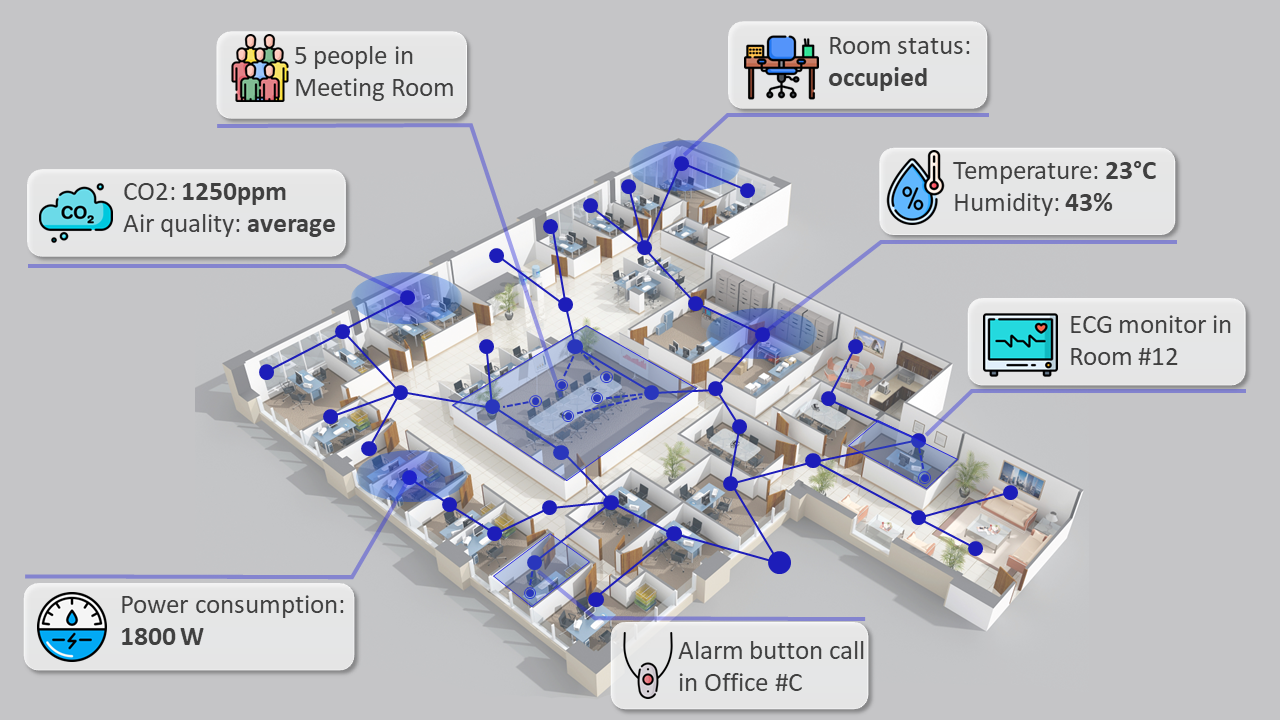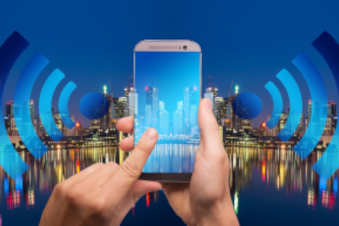Introduction
We have already talked in one of our previous articles about the numerous advantages of Smart Buildings in the field of energy
efficiency and sustainability (Smart Buildings: sustainability and energy efficiency).
Smart Building, however, is not only synonymous with energy efficiency and sustainability, but also with comfort and health for those who reside there.
In the last 200 years we have profoundly transformed our lifestyles and today people in industrialized nations spend 90%
(US Environmental Protection Agency)
of their time indoors: we have gone from living mainly
outdoors to a modern existence made up of houses, offices, shops, gyms, factories, and
other enclosed public and private spaces. These lifestyle habits inevitably have consequences on our health.
The Ministry of Health, for example, reports, using some studies
conducted on offices and other buildings for public use in various countries, that a frequency of disturbances among the occupants of between 15% and 50%
has been detected.
For years already the relevance of the so-called "sick building syndrome" has been ascertained. This Syndrome can be defined as a series of
short-term (eye, nose, throat irritation, headache, tiredness, difficulty in concentration) and long-term ailments
(respiratory diseases, asthma, ...) caused by poor air quality (reduced air exchange, lack of ventilation, inadequate air conditioning systems, ...).
The US Environmental Protection Agency also reports that indoor air
is 5 times more polluted than outdoor air; its poor quality is primarily associated with a high concentration of carbon dioxide, as well as non-optimal
humidity and temperature values.
Considering that, as reported by the Ministry of Health website, it is estimated that 15% of the population, equal to about 10,000,000 people, study or
work every day in about 45,000 public buildings throughout the country, from 4 to 8 hours per day, indoor air quality becomes a health determinant,
especially for the most vulnerable groups such as children, adolescents and allergy sufferers
and asthmatics.
The Covid-19 pandemic has brought even more attention to the importance of maintaining good levels of air quality as it has been scientifically proven
that high levels of CO2 indoors are linked to a higher rate of infection by viruses, such as SARS-CoV-2.
The main parameters that are taken into consideration to determine the air quality in indoor environments are the percentage of humidity in the air
and the concentration of two of the main pollutants: CO2 and VOC. But there are also many other pollutants, such as combustion gases (NOx, SO2, CO)
that come from outside, and other pollutants that are generated indoors, such as PM 10 and PM 2.5 fine particles.
In short, the invisible enemies are many and difficult to detect, but fortunately new technologies come to our rescue,
and they can help us concretely improve the quality of the environments where we spend most of our days.
IoT technologies for healthier buildings: improving the quality of indoor environments
Smart Building technologies come into play precisely with a view
to monitoring the quality of indoor environments. In fact, living in smart buildings means having
the possibility of counting on buildings capable of ensuring comfort and quality of life, also in
terms of health, which are decidedly better than those of the past.
Optimized environments increase well-being in residential and work spaces, and significantly reduce health problems.
The importance of living and working in healthy environments is also underlined by
D.Lgs 81/08 (Consolidated Law
on Health and Safety in the Workplace)
which prescribes compliance with specific requirements in closed environments, in relation to the microclimate (ventilation, temperature and humidity)
and air quality, but also lighting and noise.
In this regard, the WHO (World Health Organization)
in 2009 published important guidelines for indoor air quality, in which it provides practical
indications to guarantee
the salubrity of indoor air and to identify health risks through some indicators.
Buildings equipped with wireless IoT sensors, with which it is possible to monitor
air quality, carbon dioxide levels and other pollutants
present in real time, can be the solution to guarantee healthy environments.
The importance of living and working in comfortable and healthy environments is confirmed by the results of a
research conducted by the Universities of Harvard and Syracuse which showed that
CO2 and VOC levels decrease cognitive abilities. The same study showed that thanks to the adoption of technologies
capable of monitoring air quality and ensuring comfort and well-being, the situation clearly improves and the cognitive
abilities and productivity of the occupants increase.
The use of these technologies is becoming increasingly popular, and market data proves it. According to a study by
Future Market
Insights, Global Air Quality Monitoring Systems Market to Exceed $10 Billion in 2029, reporting revenue to double from 2019 to 2029.
Smarter and healthier buildings thanks to retrofit technologies
The need for healthier buildings fits into the broader context of the Smart Building, i.e. the set of practices and technologies that make possible to create buildings capable of managing resources in an optimal way (primarily energy, but in general all the resources that refer to the activities that take place inside the building) and to provide the best possible comfort to those who use them (comfort which translates, as we have already anticipated, into a healthier and safer environment).
Some data allow us to understand how important is actually to favor all those technologies and solutions that can allow to make a building smarter and healthier:
• buildings are responsible for around 40% of energy consumption. Greater energy consumption translates into greater production
of CO2 in the atmosphere and therefore greater outdoor and indoor pollution: their reduction passes, in addition to the adoption of innovative construction
technologies for new buildings (nZEB, near Zero Energy Building), from implementation of advanced monitoring and control solutions;
• buildings are the second highest cost for companies, and it is therefore important to ensure that
the available space and the physical resources contained within it are used in an optimal way;
• high levels of CO2 and poor air quality lead to short-term and long-term disturbances to the occupants.
Furthermore, studies on the mechanisms of viral transmission indoors have shown that, more than the density
or quantity of people present, it is important to guarantee an adequate level of ventilation or air exchange:
when the level of CO2 increases it is very likely that it is also increasing the concentration of aerosols, a potential vehicle for viruses.
The reading of these data and the consequent emergence of the need for solutions and technologies for the adaptation
of buildings towards a "smart" concept, fits into a context of building heritage such as the Italian one (not dissimilar to that of other western countries)
which sees 85% of buildings built over 30 years ago.
It follows that the adjustment interventions must provide for the adoption of technologies suitable for retrofitting: retrofit interventions
technological represent a specific declination of the redevelopment of buildings where this is implemented through innovative technologies and products
aimed at adapting the pre-existing infrastructures to new needs, offering new services or services not originally envisaged.
The MeshCube platform developed by BlueUp, described in the following paragraph, fits exactly into this context and responds to
the need to transform indoor environments into intelligent environments thanks to an innovative technological solution.
MeshCube: All-in-One IoT platform for Smart Building
MeshCube is a multi-service IoT platform for Smart Buildings that uses a highly energy-efficient radio mesh infrastructure capable of interconnecting various smart devices and sensors located inside the building (inside rooms, worn by people, applied to physical assets,…). This network of sensors creates, in fact, a digital twin (digital twin), which models the "environment-building" with everything that moves inside it (users, workers, devices, ... ).
MeshCube is a wireless and cable-less solution:
• wireless because communication between devices takes place via radio technology;
• cable-less because, thanks to the reduced energy consumption,
the devices can be powered by batteries without the need for cabling or expensive IT infrastructure.
The services offered by MeshCube include:
- monitoring of climatic and air quality parameters;
- control of field sensors and actuators;
- localization of people and assets inside the building;
- identification and geo-location of alarm events (call button, man-down, collision, fall);
- management of fleets of Bluetooth® LE beacons used for indoor navigation and wayfinding applications.

Because of this intrinsic characteristic of multifunctionality,
MeshCube is not limited exclusively to the Smart Building market in its classic meaning (offices, residential, ...),
but to all indoor contexts that can become "smart":
Smart Healthcare: hospitals, nursing homes, homes for the elderly and dependents;
Smart Factory: manufacturing industry, service industry, warehouses and internal logistics;
Smart City: schools, public spaces (museums, stations, airports, ...).
Do you want to find out how BlueUp solutions and technologies can help you make a building healthier and more comfortable?
Contact us to find out more.
We will be happy to help you! 😊
Related content



